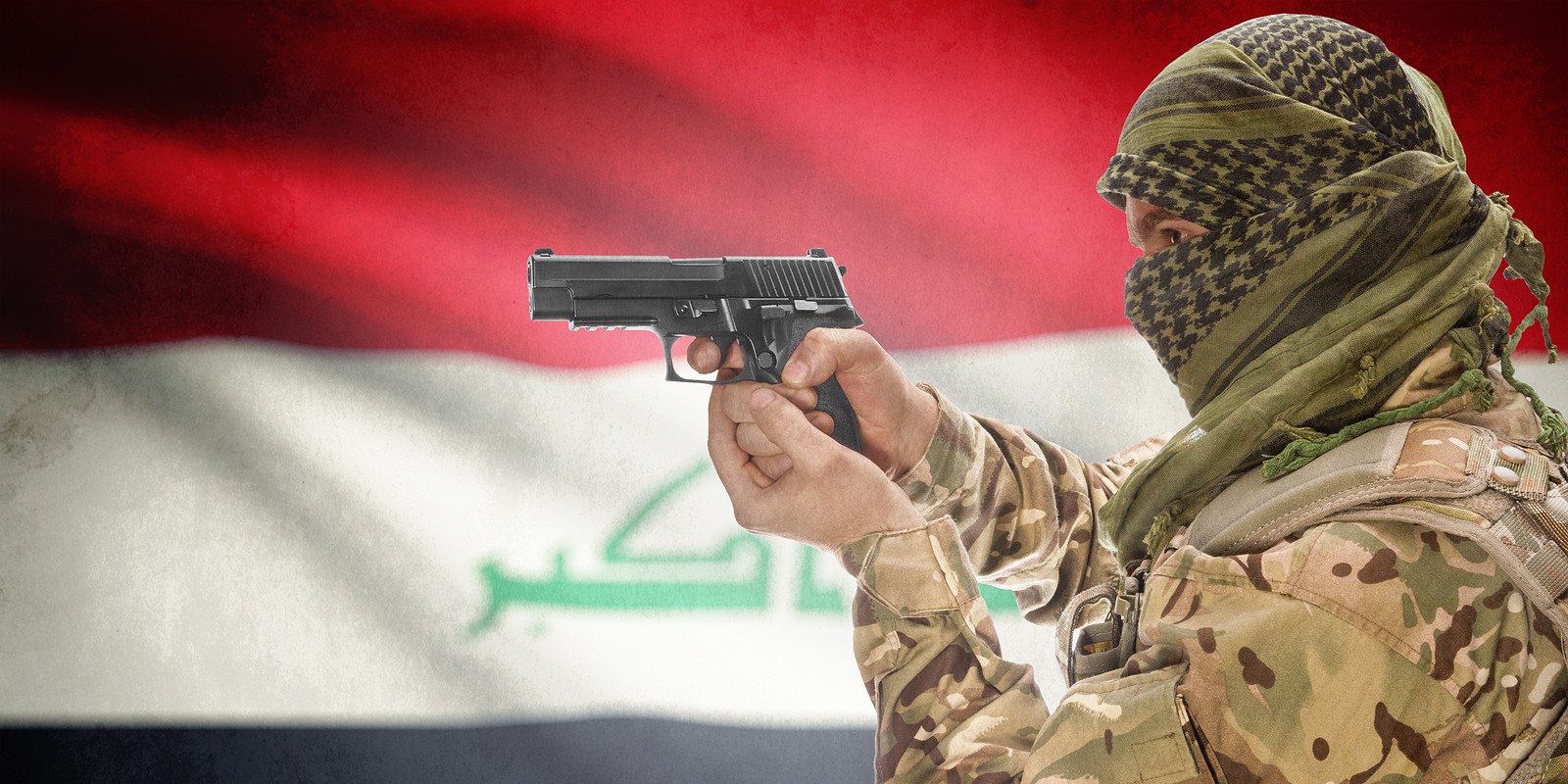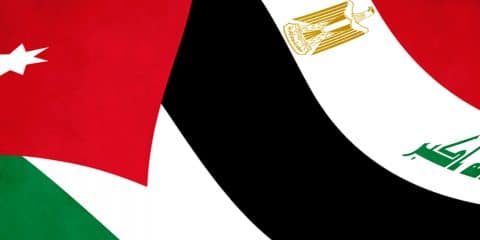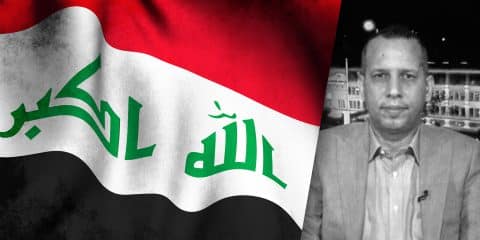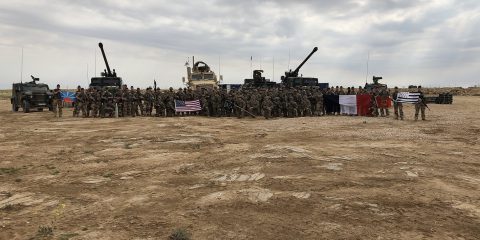Iraq is already part of the northern crescent of threats facing Israel. The US presence, broader policy regarding Iran makes Israeli action in Iraq more complicated than in Syria.
A previously unknown Iraqi Shia militia calling itself Ktaib al-Sabiqoun issued a warning to Israel this week. In grammatically challenged Hebrew, the statement read, “If you bomb us, we will bomb you.” It is likely that this statement was in fact issued by one of the established pro-Iranian militias. It is common practice for these organizations to adopt and discard new names when engaging in areas beyond their usual zones of activity.
Ktaib al-Sabiqoun’s warning comes in the wake of a recent comment by Prime Minister Benjamin Netanyahu hinting that during the recent fighting in Gaza, Iran sought to send an armed drone toward Israel from “Iraq or Syria.” The statement also coincides with growing concerns in Washington regarding the increasing intensity of the Shia militias’ campaign against the US presence in Iraq, specifically in the area of drone attacks. At the public level in Iraq, meanwhile, protests took place this week against the ongoing murder campaign by the Shia militias against Iraqi civil society activists and oppositionists.
All these sets of events are linked. The Iranian strategy for Iraq is clear, and resembles in its essentials the project already close to completion in Lebanon. It is exemplified by the targeting of the three enemies noted above – namely Israel, the US/West, and the domestic opponents of Iran’s local proxies.
The intention, along the lines of what has already been achieved in Lebanon, is that the formal structures of representative government should remain, but should be emptied of any meaningful content. Political military structures in the service of Iran will enjoy freedom of action and will possess military capacities superior to those of the nominal forces of the state.
The latter, meanwhile, will themselves be thoroughly penetrated by the Iranian power structure. Political forces hostile to this project will be disposed of, or intimidated into, silence. The territory of the country will then be used both for the transportation of men and materiel in the direction of Israel, and for the deployment of missiles capable of reaching the territory of the Jewish state. The Iranian intention, as seen in Lebanon, Syria and Yemen, is not to create a strong, coherent client state in Iraq. Rather, Tehran wants fragmented, dysfunctional structures within which the only powerful, cohesive element is the Iran-supported force itself.
At present in Iraq, this project is underway but is not yet near completion. A significant barrier to the realization of Tehran’s goals is the remaining US military presence in the country. There are strong indications at present that the long smoldering Shia militia campaign against the US is set to increase in intensity. The intention is to pressure the US into departure.
In the latest incident, a rocket was fired at the Ain al-Asad base last week. US personnel are stationed at the base. Following the incident, Iraqi authorities arrested Qasim Muslih, commander of the Shia militias in Anbar Province. In response to the arrest, the militias then conducted a show of strength against the Green Zone, the center of the international presence in Baghdad. Heavily armed Shia militiamen traveling in military vehicles seized control of entry and exit points to the zone, holding them for several hours before dispersing.
A number of articles in the US media in recent days have noted growing concerns in the US defense establishment regarding the tempo of militia attacks using drones or missiles against US facilities and personnel in Iraq. The Daily Caller political-opinion website quoted “security sources” who reported that the Pentagon intends to ask President Joe Biden for permission to carry out counter strikes against militia targets in Iraq. According to the report, the White House currently insists on green-lighting all US responses to militia attacks, and “The Administration is looking hard at a broad range of responses to Shi’ite militia aggression against Americans in Iraq.”
Against the background of the militia campaign, popular protests against the militias and their campaign of assassinations resumed this week. Gathering under the slogan “Who killed me?” demonstrators in Baghdad on May 25 protested the killing of civil society activist Ihab al-Wazni in the majority Shia town of Karbala on May 9.
According to one demonstrator interviewed by the Middle East Center for Reporting and Analysis (MECRA) in Baghdad, “Al-Wazni is dangerous for them and their interests, so they killed him to protect themselves. These groups are always out there with guns, and they are continuing targeting people, and they are the only ones permitted to hold weapons. They are responsible for killing demonstrators and activists. The forces that are coming on the streets are supported by Iran and they are taking orders from them.’”
Another protester, Ali al-Khafaji, told MECRA, “Agents have come from east of the border to destroy Iraq…. Wilayi (Pro-Iranian) militias and hired killers from Iranian intelligence are the ones who came from the east… Iranian Revolutionary Guards and Iranian Ministry of Intelligence. These two entered Iraq to make bloodshed here and to destroy it.”
Since large-scale protests began in October 2019, around 600 demonstrators have been killed. An additional 82 Iraqis have lost their lives in targeted killings. At least one demonstrator was killed when security forces opened fire on the crowd in Tahrir Square on May 25. Participants claimed that the police commanders who gave the order to open fire are themselves members of the Badr Organization, a pro-Iran militia with a strong presence in the Iraqi police and security forces.
It is unclear if determined US action against the threat of the Shia militias will take place. The administration is engaged in negotiations on the nuclear issue with Tehran. It is likely that the determination to sign a new deal as soon as possible will prevent a determined and comprehensive response.
For Israel, events in Iraq are of deep relevance. Iran has already deployed missiles in the deserts of western Iraq, in the hands of its militias, which have Israel within range. The Iranian-made Zolfaqar missile has a claimed range of 750 km. (466 miles), putting Tel Aviv within its range if it is deployed in western Iraq. The distance from al-Qaim on the Iraqi-Syrian border to Tel Aviv is 632 km (393 miles).
In the event of the “1st Northern War,” as Israeli defense planners call the scenario of a general war between Israel and Iran with its proxies, Iraq would play an important role in the transfer of weaponry. The Shia militias would be used to provide additional manpower for the Iranian side, as seen in the Syrian civil war. Missiles would almost certainly be launched from Iraqi soil.
Hence, whatever the origins and the seriousness of Ktaib al-Sabiqoun’s message, and the statement by Netanyahu that preceded it, Iraq is already part of the northern crescent of threats facing Israel. The US presence and broader US policy regarding Iran makes Israeli action in Iraq more complicated than similar actions in Syria, or potentially in Lebanon. As Israeli planners assess the Gaza events of recent weeks in light of the key scenario of a future war from the North, the growing threat from Iraq is likely to be a significant factor in their deliberations.
Published in The Jerusalem Post 04.06.2021
JISS Policy Papers are published through the generosity of the Greg Rosshandler Family.
Photo: Big Stock








 - בניית אתרים
- בניית אתרים